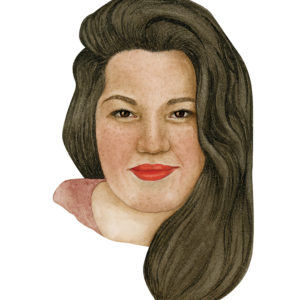When Trae Q L Venerable gets to the barn, he immediately texts his wife, Jasmine, to let her know that he’s getting started. Then he slides his iPhone in his back pocket and leaves the world behind. He greets Stormy, his two-year-old filly, with a tip of his hat and a low murmur. It’ll be at least three hours before he feels a faint buzz through his denim, the world calling him back.
Time evaporates when he’s working horses, Venerable has noticed. He can’t help it. He is a born cowboy, comes from a long line of cowboys, knows horses like he knows his own face.
“There’s something really God-given from a horse, and knowing that is the core of being a horseman, a cowboy,” he says. “If you can train a horse, there’s not a lot of things in life you can’t do.”
Venerable has an easy confidence about him, an unhurried, earnest, Johnny Cash-like vibe. When we meet, he wears stylish thick-framed glasses, dusty black jeans and a black T-shirt. He is missing the archetypal accessories. There is no wide-brimmed Stetson, no pointy-toed boots, no engraved belt buckle or bolo tie. And yet he is every inch the cowboy.
“My family was cowboying before it was cool,” he says with a wry grin.

He means it. His forebears were slaves who homesteaded in southern Missouri and Kansas after the Civil War. Back then, cowboying was among the few opportunities afforded to freed Blacks. Historians estimate that at least one in four cowboys were Black, though the true percentage is likely higher.
“I remember reading a Rolling Stone article a few years ago [in 2019], when Lil Nas X released that song ‘Old Town Road,’” Venerable says. “It talked about how everyone wants to be a cowboy, but no one really knows what it means.”
It was the first time in recent history that Venerable could recall a conversation about Black cowboys taking place on a national level, and he was glad for that. One year earlier, Venerable released Notables from the West, the first book in his children’s series called “Grandpa, I Just Want to be a Cowboy.” In the book, readers learn along with protagonist Bo about the legacy of Black cowboys from Bo’s Grandpa Leroy. Venerable has released two more books in the series since then and has embarked on six book tours to elementary schools, where he tells the story of the Black cowboys that history forgot. He focuses particularly on the lower Midwest.
“There is a history of cowboying in Kansas City, on both sides of State Line, and there are still quite a few riding clubs,” Venerable says. (His great-uncle, DA, founded a Black saddle club called the Walkers in Olathe.)
Venerable is right: You can’t have a cowtown without cowboys. The Kansas City Stockyards opened in 1871, making Kansas City a pivotal stopping point along the Union Pacific Railroad (then the Kansas Pacific). More than 167,000 head of cattle passed through the Stockyards in its first year, a figure that doubled over the next two years. The convergence of the Stockyards, the emerging railroad lines and the post-Civil War demand for beef provided Kansas City with a booming industry. The city grew at more than double the national average, and in 1899, when the American Royal Agricultural Show launched—thanks in large part to the work of Tom Bass, a Black cowboy and legendary horse trainer—its population was around 160,000. Less than four decades earlier, in 1860, Kansas City counted just 6,000 residents.
None of this could have been done without Black cowboys.
Back in the Saddle
Venerable boards Stormy at Hackberry Farms in Kansas City, Missouri. Like most Tennessee Walking horses, she is long and lean, with a graceful neck and powerful hind quarters. Venerable visits her every day. She is almost broken—that is, ready to ride. Venerable has gotten her used to wearing a saddle, but she’s not quite ready for anyone to sit in it.
“You’re breaking the horse’s will so that they submit to yours—that’s the old cowboy way to say it,” Venerable says. But it has less to do with cowboy power trips and more with responsible horse training. “If you get off while they’re doing something crazy, you just taught this horse that they can do that.”
Stormy’s head looms over Venerable’s by a good six inches. Her rich chocolate coat is taut over her muscles, gleaming when light catches it, and there is not one hair out of place in her dark mane.
“Stormy is between eight hundred and nine hundred pounds,” Venerable offers. “She could kill me. You never push a horse to do anything—you ask them. You learn to speak their language. When I’m working with Stormy, I can tell she wants to please me. And there’s nothing in this world like that feeling when your horse understands on your level what you’re asking them to do.”
Stormy is the only horse Venerable owns outright. DA, the great-uncle who passed on the family’s cowboy tradition, keeps a handful of broodmares at his farm in Spring Hill, Kansas, and Venerable also helps with them. Venerable intends for Stormy to be a trail horse used for pleasure riding, though he does hope to show her at the American Royal. This work, along with the book writing and touring, is in addition to his career as an engineer at Honeywell.
“I’m a hybrid cowboy–that’s what DA always told me, because I don’t live on an operation,” Venerable says. “My dad called me an urban cowboy. But if you want to look at it from a horseman standpoint, the horses come and go. DA has had many horses over the years. There are seasons where there is lots of breeding, lots of selling, lots of training. Right now, I’m low on horses, but it all depends.”
In Hartville, Missouri, Venerable’s cousins maintain a sizable livestock operation. Horses are a key part of it, but for that side of his family, the business is beef. “They’re cattlemen,” Venerable says.
That the family uses any horses to manage the herd is notable. Since the decline of horse-drawn farming, the cattle industry is one of the few left that employ horses—though plenty of operations are replacing them with ATVs.
“A four-wheeler just takes gas, while a horse will cost you every day of your life. Think about the maintenance, vet bills, equipment, shots,” Venerable says. “I was raised knowing that the amount of money you pay for a horse, the lump sum you hand over at the beginning, is the cheapest part. And that number could be $10,000 or more.”
Cowboying today ain’t cheap, and it’s hard to earn a living doing it, too. A horseman can make money from breeding, and breeders can sell horse semen for unholy sums, but it usually takes a championship horse to bring the bank. Venerable jokes that flushing a $100 bill down the toilet would be a better investment—and far less work—than getting into horses.
But he was born into it. He’ll never be without at least one horse. And who knows: At twenty-eight years old, Venerable has plenty of time to decide if he wants to shake off the “urban.” There is plenty of acreage in the family, and land is critical to horsemanship, too.
Venerable has a fourth children’s book, Let ’Em Walk On, due out this year. He shares some of his story with the kids he visits on his book tours, but he isn’t trying to inspire a new generation of cowboys. Venerable is a preservationist: With so little Black representation in history books, he wants kids—especially youths of color—to know that there is more to their story.
“If you don’t know where you’re from, you don’t know where you’re going,” he says, paraphrasing Maya Angelou. “I want to let Black and brown kids know that they don’t have to play ball or write music. I want them to know that they have been cowboys, that this is in their blood, too. I hope it helps them shape their own narrative.”






